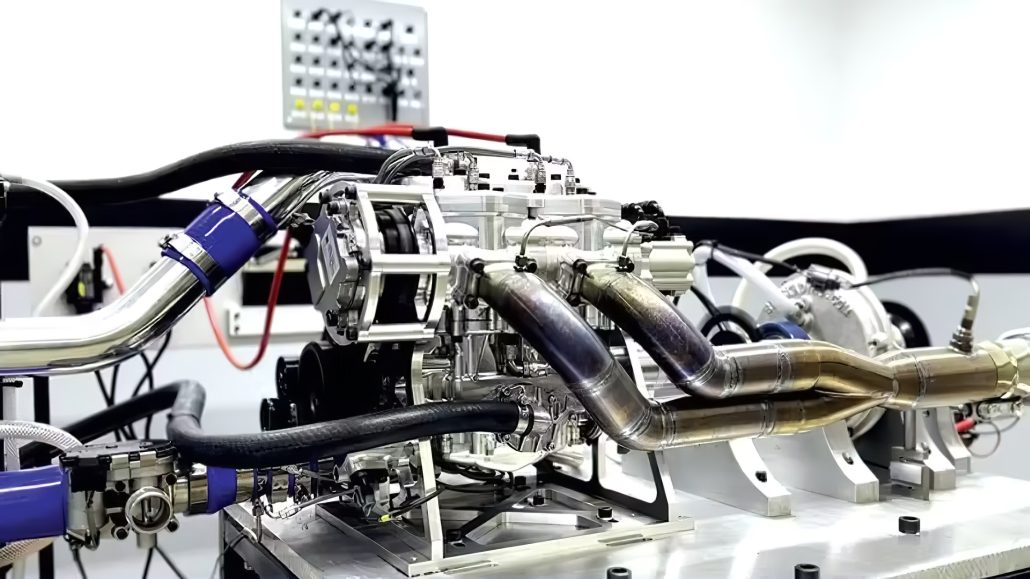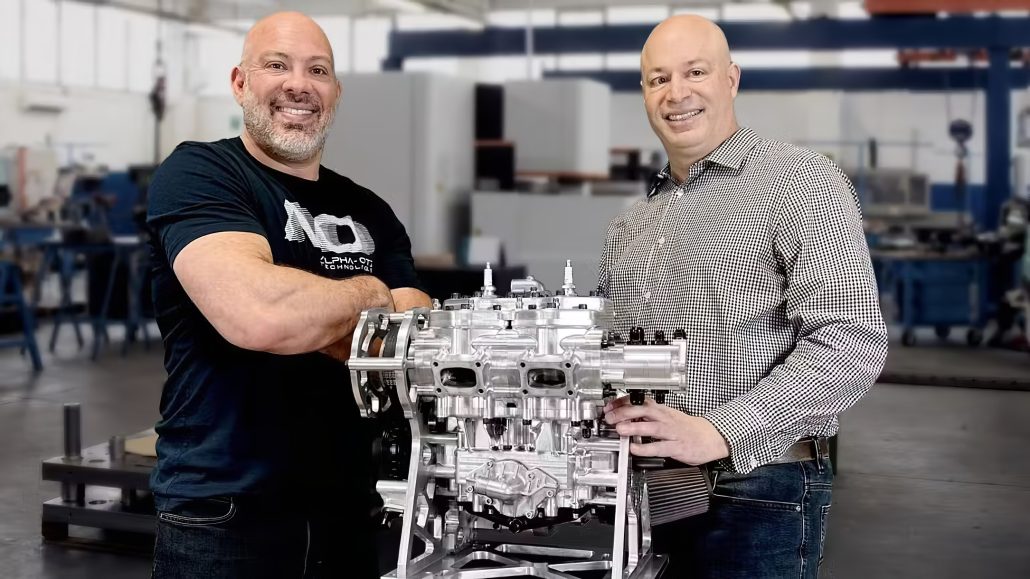The concept: high-tech meets efficiency
The REV Force is a water-cooled inline two-cylinder engine with supercharging, direct injection, and rotating exhaust control. What makes this engine special is its complete control of airflow, compression, mixture formation, and cylinder filling—all dynamically and precisely controlled. The piston is no longer responsible for sucking in the mixture. Instead, a separate system takes control, which increases efficiency and reduces emissions.
This “decoupled breathing” offers several advantages thanks to the Alpha-Otto innovation: the engine delivers maximum power when needed, but can just as easily run on an extremely lean mixture to save fuel. The drive concept thus promises driving pleasure and efficiency in one.
Versatile and future-proof: the fuel plays (almost) no role
One of the most important features: the REV Force is extremely fuel-flexible. Thanks to variable control of air volume, air temperature, mixture, and compression, the engine can use almost any fuel – from gasoline and diesel to ethanol and natural gas to hydrogen or even ammonia. The engine control system recognizes the fuel and automatically adjusts the parameters. In combination with renewable fuels, virtually CO2-neutral operation can be achieved.
Impressive performance data with compact weight
Alpha-Otto specifies a peak output of 173 hp (127 kW). The option of using the 127 kW directly for power generation opens up further application possibilities, for example as a generator. No information on speed is available yet, but five-digit values are likely.
The weight is also remarkably low: at only 48 kg (equivalent to around 106 lbs), the REV Force remains significantly below comparable units – while at the same time offering high power output. Its compact design makes it particularly interesting for motorcycles and light vehicles.
Low emissions and high efficiency
The developers promise a thermal efficiency of 50 percent or more. By comparison, modern diesel engines achieve just under 50 percent, while gasoline engines often only achieve 20 to 35 percent. This is made possible, among other things, by complete control over the mixture formation, the decoupling of the oil circuit from the fuel lubrication, and an intelligent exhaust gas recovery system. This is intended to significantly reduce emissions such as CO₂, NOx, and unburned hydrocarbons—allegedly even to near zero when running on hydrogen.
Low maintenance and durable
Thanks to the two-stroke principle and the absence of camshafts or complicated valve trains, the REV Force has fewer moving parts than a four-stroke engine. This facilitates maintenance and repair and reduces costs. Dry sump lubrication also ensures less wear and tear. Alpha-Otto specifies an inspection interval of 2,000 operating hours – a value that is particularly interesting for professional applications.
Versatile applications
The developers are still keeping quiet about the specific application. There is talk of motorcycles, light vehicles, generators, and even applications in aviation and shipping. With its high power density and low weight, the REV Force would be ideal as a motorcycle drive, but also as a compact power source in the form of so-called “Power Cube” generators, which can generate up to 100 kW of power as a hybrid system.
Innovation and market strategy
Alpha-Otto is focusing not only on technological innovation, but also on a clever market launch. Series production will not be carried out in-house, but through partnerships with established manufacturers. The first prototypes have already been built and successfully tested – including with alternative fuels such as hydrogen, ethanol, natural gas, and more. According to the company’s own data, emissions in tests with gasoline are 30 percent lower than with conventional engines. In addition, international patents have been applied for and already granted.
Initially, the REV Force will be used to power Power Cube generators before it could be used in various types of vehicles in the medium term.
Financing, vision, and outlook
The start-up is led by experienced founders from the engine industry. Development was financed in part by approximately €1.1 million ($1.2 million) in government grants. Another round of financing is now underway to bring the engine to series production and market launch. The goal: to transform the combustion engine into a clean, flexible, and sustainable power source for the 21st century.
Whether the REV Force will actually find its way back onto the road and rehabilitate the two-stroke engine as the engine of the future remains to be seen. One thing is clear, however: this technology brings the vision of a powerful, versatile, and low-emission combustion engine one step closer.
- Abrieb- und Reißfestigkeit belüftet und atmungsaktiv Anti-Pilling Material
Letzte Aktualisierung am 2025-10-15 / *Affiliate Links / Bilder von der Amazon Product Advertising API


















